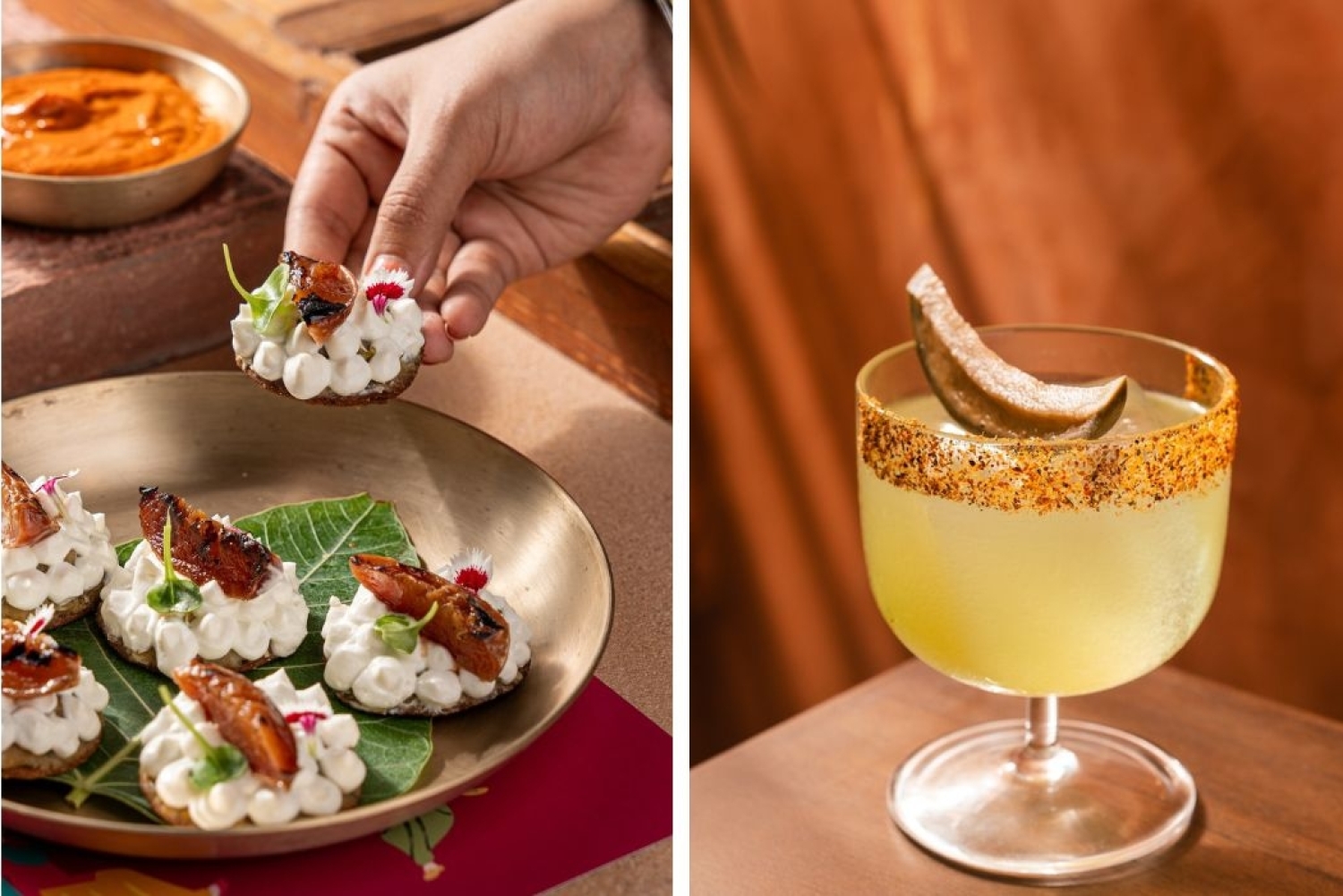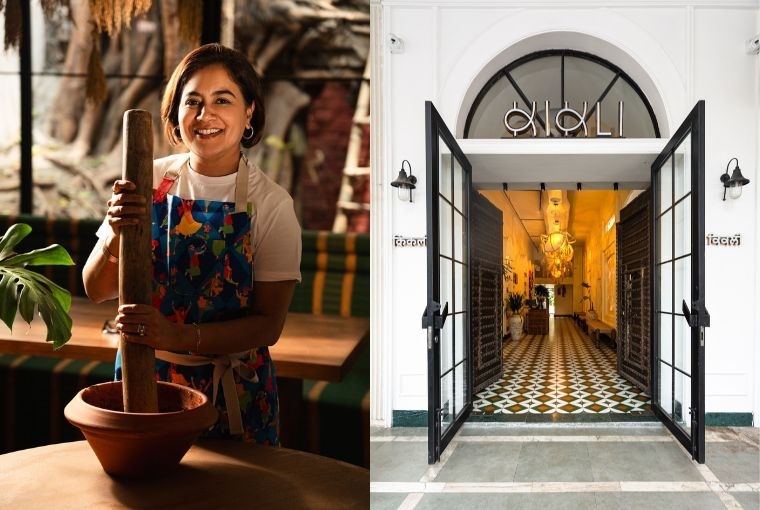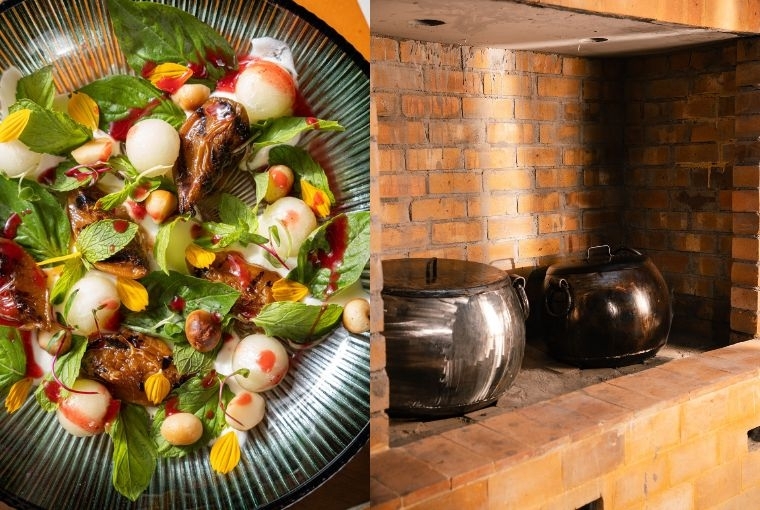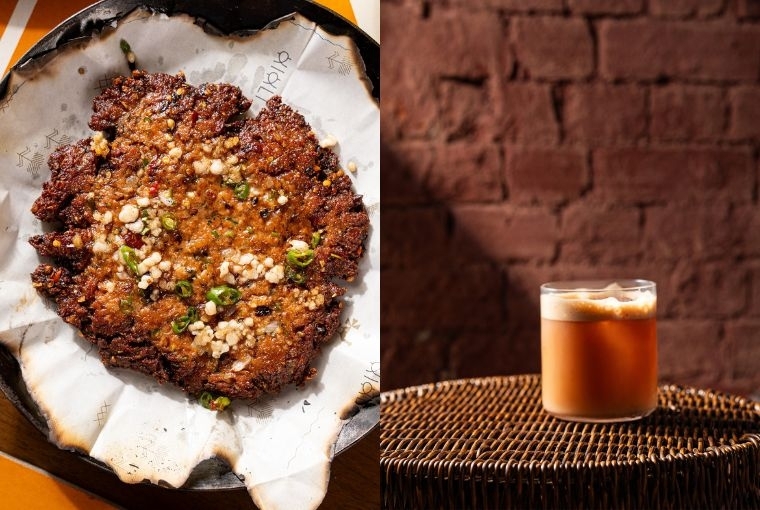
L-R: Bajra Papdi, Ambi Picante

L-R: Bajra Papdi, Ambi Picante
With her restaurant Kikli, Chef Amninder Sandhu is on a mission to challenge long-held stereotypes about Punjabi cuisine. She took over an old heritage site in Delhi and transformed it into an elegant space that celebrates the richness of her culture. ‘I just felt a very strong sense of responsibility to put the right light on Punjabi cuisine and culture because it's iconic. It's used and abused but not done right and there are too many stereotypes and cliches around all things Punjabi. I felt like someone had to do this.’
Kikli offers an authentic taste and feel of Punjab right in the heart of Connaught Place. From chown-poorana mudwork on the walls and carefully sourced local ingredients in both food and drinks, to the magnificent hara, the large traditional cooking vessel, proudly displayed at the entrance, every detail at Kikli speaks of Punjab in its purest form.

L-R: Chef Amninder Sandhu, Kikli entrance
Kikli is a massive space much like Chef's prior outing in Goa called Bawri that celebrated North Indian cuisine. Kikli can seat upto 130 people and is divided between two dining spaces and a bar. One of the dining spaces is open-air and sits right next to the open kitchen, where you see the solid young team being led by an even more enthusiastic Chef Amninder herself. The second is an indoor hall with deep sofa seating and the bar is tucked away in a separate chamber. The flooring nods to Punjab’s mixed materials, inspired by old verandahs, think wood, brass, earth and fire. The design of the space is vibrant, loud and bold much like the culture of Punjab. ‘I flew down to Ahmedabad and spent an entire day with our designer, Ariana Ginwala to put together the first mood board for Kikli. This is very different from the other restaurants where I feel like I have pretty much co-designed the space with her,' recalled Chef Amninder.

L-R: Aadu Salad, Haras used to cook Dal
Then comes the heart of any restaurant — the food. Chef Amninder summed it up perfectly: 'It’s in the small things; the stone you use to grind chutney, the shape of the roti, the way a paratha peels. That’s where culture lives.'
The menu showcases rarely seen dishes from the royal family of Patiala, staying away from the restaurant-constructed staples like butter chicken or dal makhani, which don’t actually have authentic rural Punjabi roots.
Highlights from our meal included the Aadu Salad, sweet peaches paired with ricotta-like chhena, macadamia nuts, fresh herbs, and a falafel dressing and the Bajra Papdi Chaat, crowned with spiced potato, yoghurt, and tangy chaat plums. When asked about the choice of nuts, the chef explained that macadamia nuts are used because Punjab is a prosperous state, allowing for the inclusion of fancy nuts. Additionally, in one of the salads known as tukdu, the chef adds Parmesan cheese. This choice pays homage to the Sikh community, which has historically supported the Parmesan industry in Italy.
The Chapli Kebab was impossibly tender, while the Bun Kebab (stuffed with dal cutlets) was a unique and satisfying bite.
For mains, the Parolewali Dal, cooked overnight in the hara, stood out for its soulful flavour, paired with katlamas and Bhindi Bharme Kadi.
The Parolewali Dal is a dish that stands out because of the history that follows it. ‘I saw Hara in a 120 year old farmhouse of Udhey Sidhu. They have a kitchen outside and we spotted the Hara which is traditionally used to cook dal. People in Punjab don't cook dal like how it's cooked in restaurants. In restaurants, they put so much cream and butter in the dal but in Punjab, it's cooked over the Hara overnight. The dal melts and becomes creamy and then it's topped with white butter to serve. And that white butter is also made at home, so it's much lighter on the palate,’ explained Chef Amninder.
In Punjab, fruit carts are typically filled with peaches, plums, and melons, which inspired the chef to incorporate these three ingredients into the menu. Each city or state showcases its character through its grocery stores and fruit carts, and in Punjab, the most common fruits are peaches, plums, and melons.

L-R: Chaapli Kebab, Jugaali Chaa cocktail
On the drinks side, mixologists Jeet Rana and Chirag Pal have created a menu that mirrors the food’s philosophy; familiar Punjabi flavours reimagined in fresh formats. Drinks are offered in “Regular” and “Patiala” pours, with refreshing bases like aam panna, ganne ka ras, lassi, and thandai transformed into inventive cocktails. We recommend the Ambi Picante for its subtle spice and the Jugaali Chaa for its nostalgic charm.
Looking ahead, Chef Amninder plans to take Kikli to major Indian cities. Her mission remains clear: to redefine the narrative around Punjabi food and culture, moving past restaurant-invented clichés and reconnecting with the flavours that have been passed down for generations.
Words Hansika Lohani
Date 15.8.2025